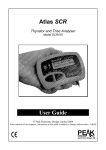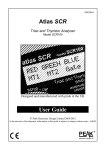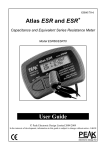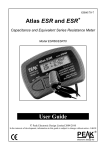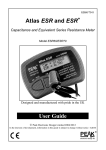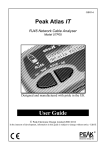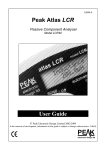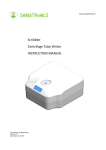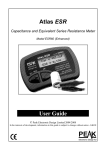Download Atlas SCR User Guide
Transcript
Atlas SCR Thyristor and Triac Analyser Model SCR100 User Guide © Peak Electronic Design Limited 2004/2008 In the interests of development, information in this guide is subject to change without notice - E&OE electronic design ltd Atlas SCR User Guide January 2008 – Rev 3 Want to use it now? We understand that you want to use your Atlas SCR right now. The unit is ready to go and you should have little need to refer to this user guide, but please make sure that you do at least take a look at the notices on page 4! Contents Page Introduction .........................................................................3 Safety Considerations ..........................................................4 Analysing components.........................................................5 SCRs ..............................................................................6 Triacs..............................................................................7 Notes on SCRs (Thyristors) and Triacs ...............................8 Gate Sensitivity..................................................................10 Care of your Atlas SCR......................................................11 Battery Replacement ....................................................11 Self Tests......................................................................12 Appendix A – Accessories.................................................13 Appendix B – Technical Specifications.............................14 Warranty Information ........................................................15 Page 2 Atlas SCR User Guide January 2008 – Rev 3 Introduction The Atlas SCR is an advanced instrument designed specifically for the analysis of SCR (Thyristor) and Triac devices. Summary Features: • Automatic component identification. • Automatic pinout identification. • Displays actual trigger (gate) current classification. • Fixed load current of 100mA. • Device test voltage of 12V regardless of battery condition. • Suitable for devices requiring gate currents up to 90mA. • Automatic and manual power-off. Page 3 Atlas SCR User Guide January 2008 – Rev 3 Safety Considerations WARNING: This instrument must NEVER be connected to powered equipment/components or equipment/components with any stored energy (e.g. charged capacitors). Failure to comply with this warning may result in personal injury, damage to the equipment under test, damage to the Atlas SCR and invalidation of the manufacturer's warranty. “Analysis of discrete, unconnected components is recommended.” The Atlas SCR is designed to provide accurate and reliable information for the majority of supported component types (SCRs and Triacs) as described in the technical specifications. Testing of other component types or component networks may give erroneous and misleading results. Page 4 Atlas SCR User Guide January 2008 – Rev 3 Analysing Components The Peak Atlas SCR is designed to analyse discrete, unconnected, unpowered components. This ensures that external connections don’t influence the measured parameters. The three test probes can be connected to the component any way round. The Atlas SCR will start component analysis when the on/test button is pressed. Analysing... The analysis typically takes less than a second to complete, after which the results of the analysis are displayed. Information is displayed a “page” at a time, each page can be displayed by briefly pressing the scroll/off button. If the Atlas SCR cannot recognise the component connected to the test probes, or the component under test is outside the specifications covered by this instrument, the following message will be displayed: No SCR or Triac detected Note: The arrow symbol on the display indicates that more pages are available to be viewed. Page 5 Atlas SCR User Guide January 2008 – Rev 3 A Silicon Controlled rectifiers (SCRs) The Atlas will analyse almost any SCR provided that a gate trigger current of no more than 90mA is required. The three test clips can be connected to the device under test any way round. If the Atlas detects an SCR, the following message will be displayed: RED GREEN BLUE Anod Cath Gate G K SCR detected Details follow Pressing the scroll/off button will then display the pinout details for the device. In this example, the Anode of the SCR is connected to the Red test clip, the Cathode is connected to the Green test clip, and the Gate terminal is connected to the Blue test clip. The gate trigger current is displayed on the next screen. Note that SCRs are often only specified to have a certain maximum trigger current – the actual (measured) trigger current may be well below that value. Trigger current IG=50 to 75mA The load current at which the SCR was tested is also displayed. This value is Tested at a load fixed for all devices, and simply serves current of 0.1A symbol indicates as a reminder. The that this is the final page of information. Pressing the scroll/off button again will return the display to the first page of information. Page 6 Atlas SCR User Guide January 2008 – Rev 3 MT2 Triacs The Atlas will analyse almost any Triac, with the proviso that a G MT1 gate trigger current of more than 90mA is not required. The three test clips can be connected to the device under test any way round. If the Triac detected Atlas detects a Triac, the following Details follow message will be displayed: Note: The device under test will be analysed in quadrants 1 and 3. The definition of these quadrants is given later in this guide. RED GREEN BLUE MT1 MT2 Gate Pressing the scroll/off button will then display the pinout details for the device. In this example, the MT1 terminal of the Triac is connected to the Red test clip, the MT2 terminal is connected to the Green test clip, and the Gate terminal is connected to the Blue test clip. The gate trigger current is displayed on the next Trigger current screen. Note that Triacs are often only IG=25 to 50mA specified to have a certain maximum trigger current – the actual (measured) trigger current may be well below that value. The gate trigger current1 displayed is that for quadrant 3. (Quadrant 1 will usually be very similar). The load current at which the Triac was tested is also displayed. This value is symbol indicates fixed for all devices, and simply serves as a reminder. The that this is the final page of information. Pressing the scroll/off button again will return the display to the first page of information. Note 1. See the “Gate Sensitivity” section later in this guide. Page 7 Atlas SCR User Guide January 2008 – Rev 3 Notes on SCRs and Triacs Silicon Controlled Rectifiers SCR Turn-On SCRs (Thyristors) act as a controlled diode. They block reverse current at all times, and they conduct in the forward direction only when triggered by a pulse of current to the control (gate) terminal. Once triggered, the SCR will continue to conduct current in the forward direction until the device is turned off. SCR Turn-Off In order to turn off a triggered SCR, it is necessary to reduce the main terminal current below the holding current for typically 5-200µS. Shorter periods may leave insufficient time for free charge carriers to recombine, and thus when main current is reapplied, the device may remain triggered. Page 8 Atlas SCR User Guide January 2008 – Rev 3 Notes on SCRs and Triacs Triacs Triacs are a well established technology, designed specifically for the solidstate control of AC loads. They offer bi-directional load current switching (for both half cycles of the mains supply) and also bi-directional gate current capability to trigger the device. The combinations of the load currents and gate control currents are referred to as “quadrants”. These quadrants are shown below: MT2 Positive (positive half cycle) Quadrant 2 Quadrant 1 MT2 MT2 GT GT The main load current is handled by the connections MT1 and MT2. The device is switched to the on state by a current into (or out of) the gate terminal with respect to the MT1 terminal. MT1 MT1 Quadrant 3 Quadrant 4 MT2 MT2 GT GT MT1 MT1 MT2 Negative (negative half cycle) Once triggered, main load current will continue to flow until a zero-cross in the mains cycle is encountered, at this point the device switches off. Therefore, if the device is to be kept on, a continuous gate current must be provided or at least a gate current pulse that occurs immediately after each mains zero-cross. Many triacs however are only capable of operating reliably in 3 of the 4 quadrants. (In particular, Q1, Q2 and Q3). Quadrant 4 (negative gate current and negative load current) can be troublesome with some triacs, suffering from poor gate sensitivity and slow response. Page 9 Atlas SCR User Guide January 2008 – Rev 3 Gate Sensitivity The Peak Atlas SCR attempts to trigger the device under test at eight discrete gate currents, in ascending order. Trigger test level 1 100µA Trigger test level 2 Trigger test level 3 Trigger test level 4 500µA 2.5mA 10mA Trigger test level 5 Trigger test level 6 Trigger test level 7 25mA 50mA 75mA Trigger test level 8 90mA First test Last test Thus, for example, a reported trigger current of 10mA means that device triggering occurred at a gate current of 10mA, but not at 2.5mA. Therefore the trigger current for the device under test is between 2.5mA and 10mA. Although Triacs are tested in both quadrants 1 and 3, the reported gate trigger current (for both SCRs and Triacs) is that which applies to quadrant 3. Page 10 Atlas SCR User Guide January 2008 – Rev 3 Care of your Atlas SCR The Peak Atlas SCR should provide many years of service if used in accordance with this user guide. Care should be taken not to expose your unit to excessive heat, shock or moisture. Additionally, the battery should be replaced at least every 12 months to reduce the risk of leak damage. Low Battery If a low battery warning message appears, replacement of the battery is mandatory. The Atlas will not continue to operate if this condition is encountered. New batteries can be purchased from many retailers and directly from Peak Electronic Design Ltd or an authorised agent. Battery types: Suitable battery types include 23A, V23A, GP23A, MN21 or a good quality 12V alkaline equivalent as used in many test instruments and automotive remote key fobs. Battery access: To replace the battery, unscrew the three screws to remove the rear panel. Remove the old battery and insert a new one, taking care to observe the correct polarity. Carefully replace the rear panel, do not over-tighten the screws. Peak Safe Battery Disposal Scheme: Please return your old analyser battery to Peak Electronic Design Ltd for safe and environmentally responsible disposal. Page 11 Atlas SCR User Guide January 2008 – Rev 3 Self Test Procedure Each time the Atlas SCR is powered up, a self test procedure is performed. In addition to a battery voltage test, the Atlas measures the performance of many internal functions such as the voltage and current sources, amplifiers, analogue to digital converters and test lead multiplexers. If any of these function measurements fall outside tight performance limits, a message will be displayed and the Atlas will switch off automatically. If the problem was caused by a temporary condition, such as applying power to the test clips, then simply restarting the Atlas may clear the problem. Error M6 If a persistent problem does arise, it is likely that damage has been caused by an external event such as excessive power being applied to the test clips or a large static discharge taking place. If the problem persists, please contact us for further advice, quoting the displayed fault code. If there is a low battery condition, the automatic self test procedure may not be performed. Page 12 Atlas SCR User Guide January 2008 – Rev 3 Appendix A – Accessories A range of useful additions is available to enhance your Atlas SCR. Carry Case A specially designed case with custom made foam compartments and a smart tough exterior is ideal for protecting your Atlas SCR and probes. There is even space for a spare battery. Replacement Probes If your probes become damaged, you may wish to purchase a new set of probes or alternatively fit a different style of probes. Replacement Battery Replacement batteries are available from Peak Electronic Design Limited, your agent or many good electronic stores. All accessories are available from Peak Electronic Design Limited or an authorised agent. Page 13 Atlas SCR User Guide January 2008 – Rev 3 Appendix B - Technical Specifications All values are at 25°C unless otherwise specified. Parameter Peak test current into S/C Peak test voltage across O/C Gate trigger current range (IGT) Battery type Battery voltage range Battery voltage warning threshold Inactivity power-down period Dimensions (excluding test leads) Operating temperature range 1. 2. Minimum Maximum 120mA 12.5V 0.1mA 90mA GP23A 12V Alkaline 8.5V 12V 8.5V 20 secs (2 secs for single screen results) 103 x 70 x 20 mm 0°C 50°C Between any pair of test clips. Subject to acceptable LCD visibility. Page 14 Typical 100mA 12.0V Note 1 1 2 Atlas SCR User Guide January 2008 – Rev 3 Warranty Information Peak Satisfaction Guarantee If for any reason you are not completely satisfied with the Peak Atlas SCR within 14 days of purchase you may return the unit to your distributor. You will receive a refund covering the full purchase price if the unit is returned in perfect condition. Peak Warranty The warranty is valid for 12 months from date of purchase. This warranty covers the cost of repair or replacement due to defects in materials and/or manufacturing faults. The warranty does not cover malfunction or defects caused by: a) Operation outside the scope of the user guide. b) Unauthorised access or modification of the unit (except for battery replacement). c) Accidental physical damage or abuse. The customer’s statutory rights are not affected by any of the above. All claims must be accompanied by a proof of purchase. At Peak Electronic Design Ltd we are committed to continual product development and improvement. The specifications of our products are therefore subject to change without notice. © 2004/2008 Peak Electronic Design Limited - E&OE West Road House, 26a West Road, Buxton, Derbyshire, SK17 6HF, UK. www.peakelec.co.uk Tel. +44 (0) 1298 70012 Fax. +44 (0) 1298 70046 Page 15















